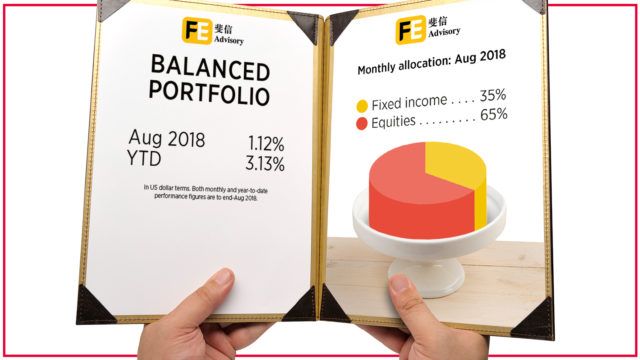Each month we feature the allocation in one of the three portfolios offered by FE Advisory Asia: Cautious, Balanced and Growth. Data is included to show how well the portfolio has done compared to the previous month and year-to-date so that readers can get a sense of performance.
Additionally, Luke Ng, senior VP of research at FE Advisory Asia, provides a concise analysis on macro events and their impact on the portfolio.
A breakdown of the Balanced portfolio at the end of August 2018*. Performance figures are in the menu image above.


Luke Ng, FE Advisory Asia
How did the market perform in August?
This month proved a mixed bag for equity investors. Some markets powered ahead while others lagged significantly. The US was the best performer out of the major economies in August with economic growth proving particularly resilient. The US Q2 figures showed an annualised growth rate of 4.2%, the highest in four years. This was principally driven by strong household spending. August also marked the point where the US entered its longest bull market in history, approaching 10 years with no significant market corrections.
In contrast, emerging markets suffered, none more so than Turkey which saw its currency slump. The strength of the US dollar continues to prove a headwind for many economies, particularly those with debt denominated in dollars. Perhaps most significantly, US tariffs of $16bn was placed on China, which quickly retaliated. The threat of a global trade war continues to send jitters across global markets.
The Eurozone struggled, with the financial sector put under pressure due to their exposure to emerging markets and concerns that Italy’s’ budget proposal will not comply with EU rules. Whilst in the UK, banks raised interest rates for the second time to 0.75%. The FTSE struggled, in particular, mining and financials companies exposed to emerging markets.
In August, the US 10-year treasury yield declined by 10 basis points to 2.86%. In addition, the US treasury yield curve continued to flatten, with spreads between 10 years and 2 years narrowing to below 20 basis points at the end of the month. US dollar-denominated investment grade and high yield corporates also posted positive returns, generally performing better than those denominated in other currencies. It was also the case for hard currency emerging market debt as they outperformed local currency instruments.
How did the Balanced portfolio perform?
The balanced portfolio rose 1.12% in August in US dollar terms, posting stronger returns than the MSCI AC World of 0.83%. While we have invested 65% of our portfolio into global equities, our call to stay away from emerging market equities except Asia proved beneficial. Our strategy selection within developed market equities also added value to our portfolio. We invested into quality growth strategies through products from Legg Mason, Jupiter and JP Morgan to tap into US, Europe and Japanese equities, respectively. They all managed to outperform their relevant markets and posted positive returns. Our call to stay with fixed income strategies, diversified across various sub-asset classes, investing into US dollar-denominated instruments (or ones hedged back into the US dollar) also helped prevent any negative currency effects.
FE Advisory Asia portfolio performance
| Jan 2018 | Feb 2018 | Mar 2018 | Apr 2018 | May 2018 | June 2018 | YTD | |
| Cautious | 1.43% | -1.58% | -0.14% | 0.06% | 0.39% | -0.52% | 0.39% |
| Balanced | 3.64% | -2.68% | -0.18% | 0.44% | 1.22% | -0.96% | 0.75% |
| Growth | 5.19% | -3.60% | -1.17% | 0.63% | 1.75% | -1.22% | 1.36% |
| July 2018 | Aug 2018 | YTD | |||||
| Cautious | 0.65% | -0.17% | 0.48% | ||||
| Balanced | 1.99% | 1.12% | 3.13% | ||||
| Growth | 2.90% | 0.29% | 3.20% |

















